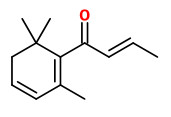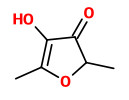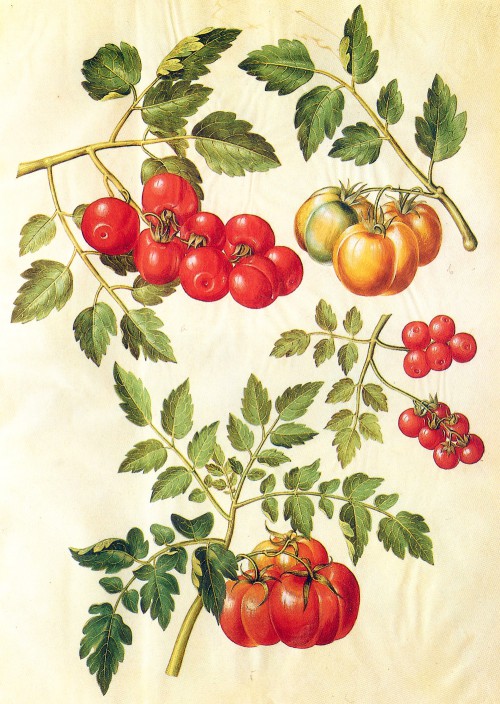Solanum lycopersicum L. - syn.Lycopersicon esculentum Mill. - Solanaceae - tomato, Tomate
Annual herb, up to 90 cm tall, only known in culture (from Ecuador, Peru); leaves imparipinnate, lobes ovate-lanceolate; flowers yellow; fruit a red (green, orange), globose, depressed-globose to pyriform berry.
„The ‘tomato’ is widely cultivated and ranks perhaps only second to the potato in food production worldwide. Several varieties are known. Eaten both raw or cooked. A source of vitamin C.“
http://www.efloras.org/florataxon.aspx?flora_id=5&taxon_id=200020545
Tomato leaves: Main volatiles of blended tomato leaves isolated by direct solvent extraction were (E)-2-hexenal (270ppm) and (Z)-3-hexenal (23ppm). The trapped scent (Tenax) of intact leaves contained mainly ß-phellandrene (25ppm), 2-carene (7ppm), limonene (4ppm) , caryophlyllene (3ppm), and humulene (0.8ppm). „Determination of odor unit values of the compounds contributing most to the leaf odor include (Z)-3-hexenal, limonene, hexanal, (E)-2-hexenal, eugenol, 1,8-cineole, caryophyllene, ß-phellandrene, humulene, and linalool.“
[Tomato leaf volatile aroma components., Buttery, R.G., Ling, L.C., Light, D.M., Journal of Agricultural and food Chemistry, 35(6), 1987, 1039-1042]
„Alkylthiazoles are well known in cooked products, but tomatoes are one of the few fresh foods where an alkylthiazole has been found. Although some isolated claims have been made for a number of alkylthiazoles in fresh tomato fruit, 2-isobutylthiazole is the only one that has been identified with certainty by many different researchers. 2-Isobutylthiazole occurs in the ripe fruit at ca. 100-300 ppb but we have been unable to detect any in the leaves or other parts of the tomato plant.“
[Buttery, R. G., and L. C. Ling. „Volatile compounds of tomato fruit and plant parts: relationship and biogenesis.“ ACS symposium series (USA). 1993, 23-34]
The headspace of tomato foliage of three cultivars Aromata, Santa Clara, and Carmen contained large amounts
of β-phellandrene (48.9-58.0%), followed by limonene (9.4-13.1%), 2-carene (3.5-16.7%), and β-caryophyllene (6.3-10.2%).
[Attraction and oviposition of Tuta absoluta females in response to tomato leaf volatiles., Proffit, M., Birgersson, G., Bengtsson, M., Reis Jr, R., Witzgall, P., Lima, E., Journal of chemical ecology, 37(6), 2011, 565-574]
Tomato fruit: „Volatile substances characterizing fresh tomato flavor are derived mainly from fatty acids and amino acids. Differences between the flavors of different varieties, the less characteristic, weaker flavor of hothouse‐grown tomatoes or artificially ripened ones, are explained by the different quantitative proportions of the volatile substances. So far no key substance playing a decisive role in the flavor of tomato has been detected. Of the approximately 400 volatile compounds so far identified, several were found, however, which have an important role in the flavor of fresh tomato (cis‐3‐hexenal, trans‐2‐hexenal, 2‐isobutylthiazole, hexanal, cis‐3‐hexen‐1‐ol, (E,E)-2,4‐decadienal, 6‐methyl‐5‐hepten‐2‐one, etc.)“
[Flavor of tomato and tomato products. Martha Petro‐Turza, Food Reviews International,Volume 2, Issue 3, 1986]
„Volatile components obtained by simultaneous steam distillation-extraction from two varieties of tomato fruits at various ripening stages and their artificially ripened tomato fruits were analyzed by GC and GC-MS using a glass capillary column. One hundred and thirty compounds were identified. Of these, quantitative changes in the major thirty-six compounds were investigated. Hexanal, trans-2-hexenal, 2-isobutylthiazole, 2-methyl-2-hepten-6-one, geranylacetone and farnesylacetone, which were estimated to be important volatile components of fresh tomato aroma by the GC-Sniff method, increased with natural and artificial ripening. However, many volatile components showed complicated changes in the case of artificially ripened tomato fruits.“
[Changes of volatile components of tomato fruits during ripening. Fumitaka Hayase, Tae-Yung Chung, Hiromichi Kato, Food Chemistry, Volume 14, Issue 2, 1984, Pages 113-124]
 (Z)-3-hexenal (green) |  2‐isobutylthiazole (tomato leaf-like) |  (E)-β-damascenone (rose apple-like) |  methional (potato-like) |  furaneol |
„AEDA and SHA-O were also applied to fresh tomatoes and tomato paste. Due to their high flavor dilution (FD)-factors, (E)-β-damascenone, acetic acid, methional, 4-hydroxy-2,5-dimethyl-3(2H)-furanone, 3-hydroxy-4,5-dimethyl-2(5H)-furanone (sotolon) and eugenol were the most important odorants in both samples. Differences in the FD-factors were found for (Z)-3-hexenal, which was the most important compound in fresh tomatoes, but without significance for tomato paste. After quantification by isotope dilution assays 15 compounds in concentration levels equal to those in tomato paste were dissolved in water. As the aroma of this mixture was very close to that of the original, the conclusion was drawn, that all of the odorants contributing to the aroma of tomato paste had been detected by the application of AEDA and SHA-O.“
[Guth, H., & Grosch, W. (1999). Evaluation of important odorants in foods by dilution techniques. In Flavor chemistry (pp. 377-386). Springer US]
„Buttery (1993) has suggested that a combination of cis-3-hexenal, cis-3-hexenol, hexanal, 1-penten-3-one, 3-methylbutanal, trans-2-hexenal, 6-methyl-5-hepten-2-one, methyl salicylate, 2-isobutylthiazole, and β-ionone, at the appropriate concentrations, produces the aroma of a fresh, ripe tomato. However, compounds with negative odor units may still contribute to the overall flavor of tomato or other foods as background notes. For this reason synthetic flavors, vanillin, for example, do not have quite the same aroma as the natural vanilla extract, which contains many background notes not present in the synthetic product.“
[Flavor trivia and tomato aroma: biochemistry and possible mechanisms for control of important aroma components., Baldwin, E.A., Scott, J.W., Shewmaker, C.K., Schuch, W., HortScience, 35(6), 2000, 1013-1021]
The amount of free furaneol seems to contribute to the flavor of tomatoes: „Furaneol was found in the highest
concentrations (660 -1100 ppb) in the summer crop of home-grown tomatoes and in some of the greenhouse hydroponically grown tomatoes, which are ripened on the plant before being transported to the supermarkets. Furaneol was found in the lowest concentrations (38-180 ppb) in the common ethylene-ripened, field-grown, supermarket tomatoes.“
[Analysis of Furaneol in Tomato Using Dynamic Headspace Sampling with Sodium Sulfate. Ron G. Buttery, Gary R. Takeoka, Michael Naim, Haim Rabinowitch, and Youngla Nam, J. Agric. Food Chem. 2001, 49, 4349−4351]
In fresh tomato fruit aroma, only a few compounds occur in concentrations well above their odor tresholds (Buttery 1989). To that group belong (OAV): (Z)-3-hexenal (50000), hexanal (630), ß-ionone (630), 1-penten-3-one (520), (E)-ß-damascenone (500), 3-methylbutanal (130), (E)-2-hexenal (16), and 2-isobutylthiazole (12). „2-Isobutylthiazole with an OAV=12 belongs to that group of compounds. Interestingly, despite the relatively low OAV, this odorant is known to be a key constituent of tomato flavorings. In 1970 Kazeniac and Hall had already reported that 2-isobutylthiazole, in amounts of 25-50 pg/kg, improves the fresh tomato note and mouthfeel of canned tomatoes.“
[Sensory relevance of volatile organic sulfur compounds in food. Blank, Imre. ACS symposium series. Vol. 826. Washington, DC; American Chemical Society; 1999, 2002]
„It has been observed that the tomato has platelet anti-aggregation activity in vitro and in vivo by inhibiting platelet aggregation induced by ADP and collagen… The various platelet anti-aggregation activity levels observed in different varieties of tomatoes can be explained by the existence of one or more bioactive compounds or different concentrations of the same compound. The platelet anti-aggregation activity of aqueous and methanol extracts of tomatoes (‘cluster’ type) in vitro were similar. Both types of extract showed inhibition of platelet aggregation (30-40%) at 1 mg/ ml induced by ADP. When collagen was used as agonist, inhibition was lower, whereas the use of arachidonic acid and peptide receptor activator of thrombin showed no inhibitory effect.“
[Platelets and atherogenesis: Platelet anti-aggregation activity and endothelial protection from tomatoes (Solanum lycopersicum L.)(Review)., Palomo, I., Fuentes, E., Padró, T., Badimon, L., Experimental and therapeutic medicine, Vol.3(4), 2012, 577-584]
http://www.spandidos-publications.com/etm/3/4/577

Gottorfer Codex, (1649-1659)
http://plantgenera.org/species.php?id_species=957028

Flora of Pakistan: http://www.efloras.org/object_page.aspx?object_id=3403&flora_id=2
